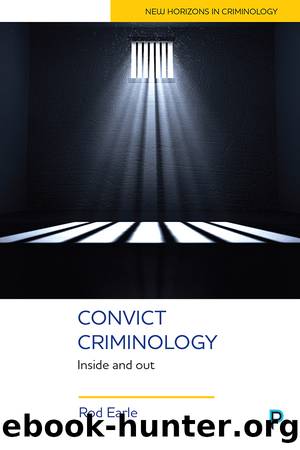Convict Criminology by Earle Rod

Author:Earle, Rod [Earle, Rod]
Language: eng
Format: epub
Tags: Social Science, Criminology, Sociology, General, Penology
ISBN: 9781447323648
Google: OKxPDAAAQBAJ
Publisher: Policy Press
Published: 2016-06-08T04:29:41+00:00
Minting stigma and handing out certificates: the Criminal Records Bureau
The tragic difference between what the State is doing now and what it was doing with the 1974 Act, in terms of criminal records, is that rather than taking them out of circulation it has started to mint them as the official currency of stigma. The Criminal Records Bureau (CRB) and its disclosure certificates are to stigma what the Royal Mint is to money. Taking criminal records from the relative obscurity of a few recruitment procedures, it has established them in public and popular discourse. Criminal records now circulate as certificates of unworthiness and execration that almost completely cancel out the principles of the Rehabilitation Act. In the United Kingdom, a country of around 60 million people, between 2002 and 2009 over 19 million criminal record disclosures were issued by the CRB (Padfield, 2011). All this, with barely a murmur of concern or a ripple of protest. All this, in a period when crime policy was trumpeted as being evidence-based and delivered on the principles of âwhat worksâ, without a shred of evidence as to their efficacy.
Criminal record checks in England and Wales are carried out by the CRB, which was established under Part 5 of the Police Act 1997 and became operational on 1 April 2002. Its stated aim was: âto help employers and voluntary organisations make more informed recruitment decisions through improved access to Government and police recordsâ (CRB, 2002, 7). The Bureau acts as a âone-stop-shopâ for organisations, checking police records and, in some cases, information held by other government departments. The Act provided for two levels of CRB disclosure, called Standard and Enhanced Disclosures.
The two CRB checks were available in cases where an employer was entitled to ask âexempted questionsâ under the Exceptions Order to the Rehabilitation of Offenders Act (ROA) 1974. Such exemptions from the Actâs provisions are made in the interests of national security, the protection of particularly vulnerable people, maintaining confidence in the administration of the law and ensuring probity in areas of banking and financial services. Exempted professions include teachers, healthcare and childcare professionals.
Before the advent of the CRB in 2002, access to police checks for criminal convictions was mainly confined to organisations in the statutory sector for staff members who had âsubstantial unsupervised accessâ to children. For other sectors, checking of police records was often carried out using the inappropriate and inefficient practice of âenforced subject accessâ (ESA) in which individuals applying for jobs or roles where scrutiny of their police records was eligible under the ROA would be ârequiredâ to obtain a copy of their police record under ESA provisions in the Data Protection Act 1998. In a review of these procedures the Better Regulation Task Force (1999) indicated that such practice was regarded by many, including the Data Protection Registrar, as a misuse of a right of access that was created for another purpose.
The launch of the CRB in 2002 established a massive expansion in the procurement of criminal records and a phenomenal rise in their public profile.
Download
This site does not store any files on its server. We only index and link to content provided by other sites. Please contact the content providers to delete copyright contents if any and email us, we'll remove relevant links or contents immediately.
The 1921 Tulsa Race Massacre by Chris M. Messer(286)
Introduction to Criminal Justice - A Balanced Approach by Brian K. Payne Willard M. Oliver Nancy E. Marion(254)
Punishing the Poor The Neoliberal Government of Social Insecurity by Unknown(249)
Russia's Sakhalin Penal Colony, 1849â1917 by Andrew A. Gentes(248)
The History of Newgate Prison by Jowett Caroline;(235)
Serial Killers America and UK - 2 BOOKS IN 1 by Clark Matthew(209)
A History of Police and Masculinities, 1700-2010 by David G. Barrie Susan Broomhall(195)
Restorative Justice in Transitional Settings by Kerry Clamp(168)
Organized Crime and Corruption Across Borders by T. Wing Lo Dina Siegel Sharon I Kwok(158)
Culture, Crime and Punishment by Ronald Kramer(155)
Cops, Cameras, and Crisis by Michael D. White Aili Malm(154)
Dangerousness, Risk and the Governance of Serious Sexual and Violent Offenders by Karen Harrison(152)
Policing Gender, Class And Family In Britain, 1800-1945 by Linda Mahood(151)
Routledge Handbook on Immigration and Crime by Holly Ventura Miller Anthony Peguero(150)
The Real CSI by Kate Bendelow(149)
Women Exiting Prison by Bree Carlton Marie Segrave(140)
Losing Legitimacy by Gary Lafree(138)
Using Murder by Philip Jenkins(136)
A Theory of African American Offending by James D. Unnever Shaun L. Gabbidon(134)
